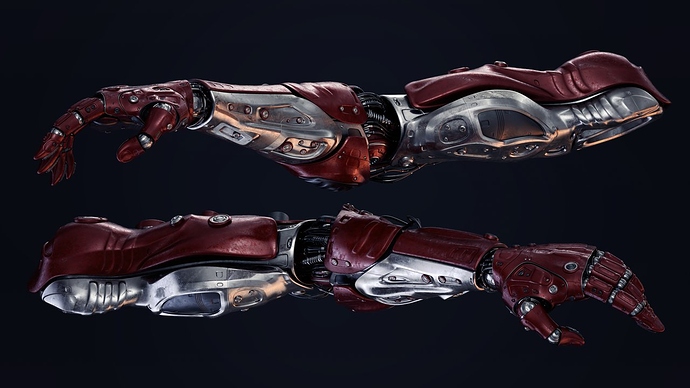(Please keep in mind that there isn’t a great deal of fine detail for cybernetics, so some of this will also be adapted from similar mediums and the like, that makes sense. Information is taken from Wookieepedia, SWG, Star Wars D20, etc.)
OVERVIEW
A cybernetic replacement was any biomechanical device used to replace body parts ranging from internal organs to limbs, which were usually lost or destroyed by disease or dismemberment.
The galaxy had centuries of advanced technology at its disposal. Among them were the ability to replace and, for a price, modify and enhance the body. While there existed more experimental forms of science to aid in these cases, they were also extremely rare and expensive. For the majority of galactic citizens, cybernetic replacements were the cheap, effective, legal, and safe solution to unfortunate and severe physical injuries.
For those willing to make the sacrifice of flesh and expense, the body could be “upgraded” to allow for additional skills and abilities. Some were very innocuous, while others involved modifying the limbs and internal systems of the potential patient. As with everything in the galaxy, this came at a potential price, in credits and in the potential loss of self. Someone could easily go too far in attempting to be “more human than human.”
When flesh failed—and sometimes even before that—cybernetics took over. Prosthetic limbs and replacement organs powered by batteries and controlled by electrical impulses were the low end of these procedures with sophisticated cybernetic hardware designed to improve or augment the recipient’s body and mind at the high end of the scale.
Artificial organs could be implanted by droids.
CYBERNETIC TYPES
Replacements: Replacements were prosthetic or artificial units intended to replace lost limbs and damaged organs. Common replacements provided no benefits other than duplicating the essential functions of their biological counterparts, and they presented little strain on the beneficiary’s overall well-being. In appearance, a cybernetic replacement was generally recognizably artificial unless covered by clothing or similar.
Enhancements: Enhancements bestowed new abilities or improved the recipient in some fashion. Enhancements included skeletal reinforcement, subcutaneous communications hardware, and weapon mounts. Some enhancements had visible external components, while others were hidden beneath the skin. Enhancements put more of a drain on the body’s resources, and recipients frequently suffered debilitating physical or mental side effects.
SYNTHFLESH, SYNTHSKIN, AND FEELING
While this is something that becomes more available in later years, during our current time period, synthflesh DOES NOT exist yet. This means that there is no way to feel anything coming from the limbs, save for something akin to real-life phantom limb syndrome. This doesn’t, however, mean the person won’t feel pain in different situations. At its core, the cybernetic is still implanted and connected up with nerves, muscles, and otherwise, depending on what it is. Having the cybernetic severed, crushed, shocked, etc, will generally lead to extreme pain from the nerve connection that allows them to move and interface with the cybernetic in question.
More on the side of synthskin, however, it has been ruled that we have a very early, rudimentary form of something like it. However, such is extremely expensive and very ugly in appearance. From a distance, it could be seen as mostly like proper skin, but up close, it becomes very obvious that it’s false.
DISADVANTAGES AND SIDE EFFECTS
Cybernetics are mechanical and electrical at their core, so they are especially vulnerable to electrical discharges, ion blasts, EMP, etc. Depending on the severity of the exposure, it could suffer anything from minor short circuits to being completely fried, damaged, and requiring full replacement. To this extent, cybernetics are a very expensive way to live. Especially for those who are frequently in combat situations. Insulation methods are available to mostly avoid electrical discharges and the like, but for fully sealed insulation and allowing the parts to still move properly and function, makes this a very expensive extra.
Likewise, cybernetics as a whole tend to bring side effects based on the type in question. While basic prosthetic replacements don’t generally lead to much in the way of side effects due to their closer emulation of standard body parts, the more enhanced side of them carry varying degrees of such. Some examples could include shortness of breath, heart palpitations, or nausea in the case of artificial organs. Body repair weaves will likely cause an overabundance of scar tissue, even in places where there was no damage. General use of enhancements to overall body parts, organs, and otherwise, will also lead to further and further detached sense of self.
All of these are also made far worse in the case of malfunctions.
CYBER-PSYCHOSIS
Cybernetic Psychosis was a condition of insanity often experienced by users of cybernetic implants or borg constructs. Essentially, the direct connection from the living brain to a computer system drove the cyborg insane over time, causing the victim to lose control over both cybernetic implant and mental facility. The onset of the condition was accelerated by prolonged connections to a computer system. Thus, the manufacturers of such devices recommended limited connection times.
Everyone had different levels of resistance to cyber-psychosis, but even the strongest of those had a very clear limit before they would completely lose their humanity and given in to the psychosis.
CYBERNETICS AND THE FORCE
The Force as a whole flows throwing living things. Cybernetics pull away from that connection due to the inorganic nature of it. As such, Force users carry different degrees of disconnect from their connection to the Force, depending on how heavily they are using cybernetics. Something small and simple generally won’t affect it much, but when you start treading into full limb replacements and beyond, the connection to the Force weakens significantly. Many Force users would even refuse cybernetic replacements, unless absolutely necessary, due to this, and instead focus on strengthening their own abilities and use of the Force in order to compensate for it.

